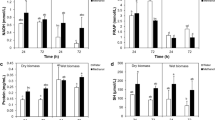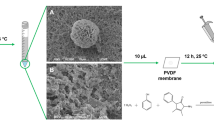Abstract
A reusable system for phenol determination in an aqueous medium was obtained by adsorption of extracellular oxidase from fungus Neonothopanus nambi onto modified nanodiamonds (MND) synthesized by detonation. It was found that the enzyme strongly binds to MND and exhibits catalytic activity in the reaction of co-oxidation of phenol with 4-aminoantipyrine without the addition of hydrogen peroxide. In the presence of the MND–oxidase complex, a significantly (by an order of magnitude) higher yield of the reaction product is recorded as compared to the yield in the presence of a free enzyme; the mechanism of the revealed effect is discussed. Model experiments have demonstrated the multiple use of the MND–oxidase complex for testing phenol in aqueous samples. The immobilized enzyme exhibits functional activity during long-term (2 months) storage of the MND–oxidase complex at 4°C. The data obtained create the prerequisites for using the created system in environmental monitoring of water pollution with phenol.




Similar content being viewed by others
REFERENCES
Knop, D., Yarden, O., and Hadar, Y., The ligninolytic peroxidases in the genus pleurotus: divergence in activities, expression, and potential applications, Appl. Microbiol. Biotechnol., 2015, vol. 99, pp. 1025–1038.
Li, F., Ma, W., Wu, X., et al., Luminol, horseradish peroxidase, and glucose oxidase ternary functionalized graphene oxide for ultrasensitive glucose sensing, Anal. Bioanal. Chem., 2018, vol. 410, pp. 543–552.
Sarma, R., Islam, M., Running, M., et al., Multienzyme immobilized polymeric membrane reactor for the transformation of a lignin model compound, Polymers, 2018, vol. 10, no. 4, p. 463.
Galperin, I., Javeed, A., Luig, H., et al., An aryl-alcohol oxidase of Pleurotus sapidus: heterologous expression, characterization, and application in a 2-enzyme system, Appl. Microbiol. Biotechnol., 2016, vol. 100, pp. 8021–8030.
Qiu, H., Li, Y., Ji, G., et al., Immobilization of lignin peroxidase on nanoporous gold: enzymatic properties and in situ release of H2O2 by co-immobilized glucose oxidase, Bioresour. Technol., 2009, vol. 100, pp. 3837–3842.
Ghoshdastider, U., Wu, R., Trzaskowski, B., et al., Molecular effects of encapsulation of glucose oxidase dimer by graphene, RSC Adv., 2015, vol. 5, pp. 13570–13578.
Koenig, M., König, U., Eichhorn, K., et al., In-situ-investigation of enzyme immobilization on polymer brushes, Front. Chem., 2019, vol. 7, p. 101.
Giannakopoulou, A., Patila, M., Spyrou, K., et al., Development of a four-enzyme magnetic nanobiocatalyst for multi-step cascade reactions, Catalysts, 2019, vol. 9, no. 12, p. 995.
Ronzhin, N., Baron, A., Puzyr, A., et al., Modified nanodiamonds as a new carrier for developing reusable enzymatic test-systems for determination of physiologically important substances, Modern Clin. Med. Res., 2018, vol. 2, pp. 7–17.
Mogilnaya, O., Ronzhin, N., Artemenko, K., et al., Nanodiamonds as an effective adsorbent for immobilization of extracellular peroxidases from luminous fungus Neonothopanus nambi to construct a phenol detection system, Biocatal. Biotransform., 2019, vol. 37, pp. 97–105.
Ronzhin, N.O., Mogilnaya, O.A., Artemenko, K.S., et al., Extracellular oxidases of basidiomycete Neonothopanus nambi: isolation and some properties, Dokl. Biochem. Biophys., 2020, vol. 490, pp. 38–42.
Laemmli, U.K., Cleavage of structural proteins during the assembly of the head of bacteriophage T4, Nature, 1970, vol. 227, pp. 680–685.
Kochetov, G.A., Prakticheskoe rukovodstvo po enzimologii (A Practical Guide to Enzymology), Moscow: Vysshaya Shkola, 1981.
Bondar, V.S. and Puzyr, A.P., Nanodiamonds for biological research, Fiz. Tverd. Tela, 2004, vol. 46, no. 4, pp. 698–701.
Ronzhin, N., Puzyr, A., and Bondar, V., Detonation nanodiamonds as a new tool for phenol detection in aqueous medium, J. Nanosci. Nanotechnol., 2018, vol. 18, pp. 5448–5453.
Author information
Authors and Affiliations
Corresponding author
Ethics declarations
The authors declare that they have no conflict of interest. This article does not contain any studies involving animals or human participants performed by any of the authors.
Additional information
Translated by M. Batrukova
Rights and permissions
About this article
Cite this article
Ronzhin, N.O., Mogilnaya, O.A., Posokhina, E.D. et al. Reusable System for Phenol Detection in an Aqueous Medium Based on Nanodiamonds and Extracellular Oxidase from Basidiomycete Neonothopanus nambi. Dokl Biochem Biophys 499, 220–224 (2021). https://doi.org/10.1134/S1607672921040141
Received:
Revised:
Accepted:
Published:
Issue Date:
DOI: https://doi.org/10.1134/S1607672921040141




